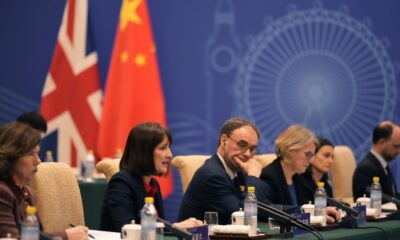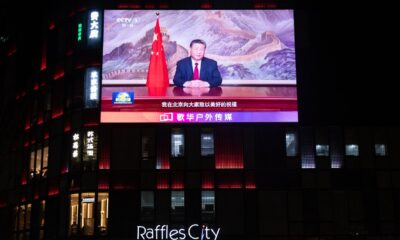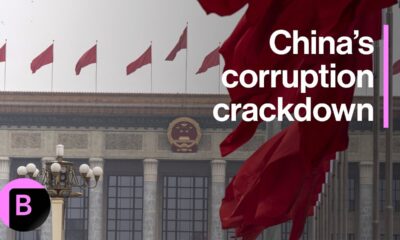China
Australia cuts off channel for China’s rich to shift assets offshore

Australia has revoked its “golden visa” immigration program targeted at attracting wealthy investors, a move that marks one fewer option for China’s rich to escape with their assets from an increasingly difficult political and economic climate at home.
Australian media reported this week that the Labor government announced in December plans to scrap the program at the end of last year because it could not bring economic benefits to the country. Also, members of the Australian Values Alliance – a group founded by Australians of Chinese heritage – pointed out that wealthy Chinese people have infiltrated politics.
The program will be replaced by a new immigration plan to provide more visas for skilled immigrants.
“It has been obvious for years that this visa is not delivering what our country and economy needs,” said Australian Home Affairs Minister Clare O’Neil in a statement Monday.
“The investor visa is one of many aspects of the system which are reforming to create a system which delivers for our country,” she added.
The Business Innovation and Investment Program (BIIP), commonly known as the “golden visa”, was launched in 2012. Unlike other visa programs, it did not require foreign immigrants to learn or master English, nor did it have age restrictions. It was only mandatory for foreign citizens to invest up to A$5 million (US$3.3 million) to obtain residence for five years.
Research by the Australian government has, however, shown that the average economic value contributed by the immigrants in this program to Australia in their lifetime is $600,000, which is just slightly more than a third of the $1.6 million generated by Australian citizens.
According to the Australian Department of Home Affairs, more than 100,000 overseas immigrants have used the program to obtain residency in the country since 2012, with 85% of successful applicants coming from China. Currently, about 26,000 people have successfully obtained permanent residence in Australia.
The visa subclass was even given the number “888”, as eight stands for prosperity and is auspicious in Chinese numerology.
China’s rich – tools of CCP infiltration
Over the years, critics have argued that the plan created not just a fast path for China’s wealthy to immigrate but had served as a conduit for corrupt officials in authoritarian countries to “move illicit funds.”
Australian commentator Huanghu Jing told Radio Free Asia Cantonese that Chinese tycoon Huang Xiangmo, who was permanently banned from entering Australia for political donations in 2019, was a “golden visa” immigrant. The biggest problem with these wealthy Chinese immigrants, therefore, is not their inability to create greater economic value, but that they have become tools for the Chinese Communist Party’s (CCP) infiltration, she said.
“Australia eventually discovered it didn’t earn much [from the program], but lost more, giving the CCP considerable penetration opportunities. A substantial number of these investment immigrants were pushed out and packaged by the CCP for all-round infiltration. Huang Xiangmo’s political donation is a typical example.”
Huangfu Jing believes that the CCP, faced with economic difficulties, has nationalized assets of China’s rich through what it labeled as “public-private partnership” schemes. As a result, she said wealthy Chinese, stripped of their wealth, will certainly flee China but at the same time, Western countries are increasingly aware of the risks and shutting their doors early.
Former Chinese diplomat Chen Yonglin claimed that wealthy Chinese immigrants who landed in Australia also brought in a legion of unproductive people with no economic contribution to the country. He said they cause social havoc with bad Chinese cultural behavior and habits, including bribery and corruption that influences politics.
Still, Chen believes that the door should remain open for these affluent affluent businessmen.
“Moving their money out will hollow out China’s economy and prompt social change; there’s no downside, in fact only benefits,” Chen said.
Apart from Australia’s “golden visa”, the “golden passport and visa” of some European Union countries are also popular among China’s rich. Countries like Malta, Cyprus and Bulgaria have issued “golden passports” to foreign investors, while Greece and Portugal granted “golden visas,” at investment prices ranging €1 million (US$1 million) to €5 million.
As early as January 2019, the European Commission warned countries offering “golden visas” to foreign investors that their schemes may help organized crime groups infiltrate the EU and increase money laundering, corruption and tax evasion and other risks.
In February 2023, Ireland announced the closure of the “golden visa” program. Portugal followed suit and stopped a similar program in March of that year.
Translated by RFA Staff. Edited by Mike Firn and Taejun Kang.
Read the rest of this article here >>> Australia cuts off channel for China’s rich to shift assets offshore
Business
China and the UK Resume Economic and Financial Discussions After Six-Year Break

China and Britain resumed economic talks after six years, aiming to improve relations. Chancellor Reeves seeks cooperation but raises concerns over Russia’s support and Hong Kong’s civil liberties.
Resumption of Talks
Taipei, Taiwan (AP) — China and the United Kingdom have reignited economic discussions after a six-year pause, spurred by British Treasury Chief Rachel Reeves’ recent visit to Beijing. The Labour government aims to mend strained relations with China, the world’s second-largest economy. Reeves met with Chinese leaders and underscored the necessity for a "stable, pragmatic" partnership, emphasizing collaboration on mutual interests while maintaining transparency in disagreements.
Economic Collaboration
During her talks, Reeves sought to address key issues such as reducing economic support to Russia and advocating for basic rights in Hong Kong. Both nations signed agreements expected to infuse £600 million ($732 million) into the U.K. economy over the next five years. These agreements target crucial sectors including finance, with Reeves emphasizing that this renewed engagement may generate up to £1 billion for the U.K.
National Security Concerns
While seeking better ties, there are mounting concerns regarding national security and human rights abuses in China. Critics from the opposition have questioned the balance between economic opportunities and safeguarding Britain’s interests. Reeves acknowledged the importance of national security but highlighted the need for pragmatic relations with global partners, stating that ignoring China is not a viable option for the U.K.’s economic future.
Source : China and the UK restart economic and financial talks after a 6-year hiatus
China
Indonesia Needs to Take a Critical Stance on China’s Global Order Vision
During his visit to China, Indonesian President Prabowo secured $10 billion in investments and issued a Joint Statement, raising concerns about Indonesia’s neutrality amid China’s global vision and territorial claims.
Indonesian President’s Visit to China
During his visit to China from November 8 to 10, 2024, Indonesian President Prabowo Subianto secured a remarkable US$10 billion in investments and issued the Joint Statement on Advancing the Comprehensive Strategic Partnership. This document has raised eyebrows as it suggests alignment with China’s global vision, potentially undermining Indonesia’s traditionally impartial stance among major powers. Notably, it includes discussions on joint development in areas with overlapping territorial claims, despite Indonesia being a non-claimant in the contentious South China Sea.
Strengthening Bilateral Relations
President Prabowo considers China a significant partner, reflecting on centuries of bilateral collaboration. This visit highlights Indonesia’s commitment to enhancing cooperation across various sectors, including technology and green energy. China also pledged support for Prabowo’s free meal program, which is part of Indonesia’s larger Food Supplementation and School Feeding initiative, reinforcing the ties between the two nations.
Implications of the Joint Statement
The Joint Statement emphasized shared aspirations for the future but also raised concerns about Indonesia’s strategic positioning. By commending China’s narrative, particularly the concept of a "community with a shared future," Indonesia may inadvertently compromise its neutrality amid major power rivalries. Given the complexities surrounding this language, it is crucial for Indonesia to approach such statements carefully to uphold its independent foreign policy.
Source : Indonesia must be critical of China’s global order vision
China
Cross-Border Data Transfers: New Draft Guidelines Clarify Certification for Personal Information Protection

China’s draft measures for personal information protection in cross-border data transfers clarify certification procedures, eligibility, and requirements. Released by the Cyberspace Administration, they aim to enhance data governance and privacy, ensuring compliance and safeguarding personal information in international exchanges.
China’s new draft measures provide clarity on the certification process for personal information protection in cross-border data transfers (CBDT). Aimed at enhancing data governance, safeguarding privacy, and ensuring regulatory compliance, the draft measures outline eligibility criteria for applying the certification mechanism, specify the requirements, and detail the certification procedures.
On January 3, 2025, the Cyberspace Administration of China (CAC) issued a draft document titled Measures for the Certification of Personal Information Protection for Cross-Border Data Transfers (hereinafter, draft measures) for public consultation. The draft measures, comprising 20 detailed articles, outline a comprehensive framework for certifying the security and compliance of personal data transfers beyond China’s borders.
With the feedback deadline set for February 3, 2025, the draft measures represent a crucial step in China’s broader strategy to strengthen data governance, ensure cybersecurity, and address global concerns over the safety of cross-border information flows.
Article 3 of the draft measures defines “PI protection certification” in cross-border data transfers as the formal evaluation process carried out by bodies authorized by the State Administration for Market Regulation (SAMR).
These certification bodies are responsible for assessing the compliance of personal information processors with the requirements of secure cross-border data transfers. The certification ensures that processors—whether domestic or foreign—adhere to the stringent criteria set out in the regulations, thereby protecting individuals’ personal information while enabling international data exchanges. Certified entities must demonstrate their capacity to manage cross-border data transfers in compliance with the standards laid out by the CAC and SAMR.
The certification process not only verifies compliance but also serves as an assurance to the public and regulatory authorities that the certified processors meet the required data protection measures.
Moreover, the scope of “cross-border data transfers” encompasses several scenarios where personal information moves across national boundaries. These include:
| This article was first published by China Briefing , which is produced by Dezan Shira & Associates. The firm assists foreign investors throughout Asia from offices across the world, including in in China, Hong Kong, Vietnam, Singapore, and India . Readers may write to info@dezshira.com for more support. |
Read the rest of the original article.






